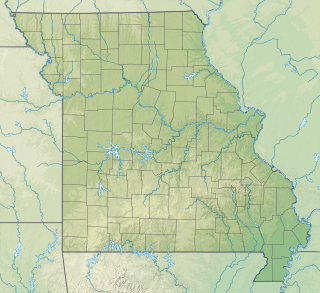
Knob Noster State Park is a public recreation area covering 3,934 acres (1,592 ha) in Johnson County, Missouri, in the United States. The state park bears the name of the nearby town of Knob Noster, which itself is named for one of two small hills or "knobs" that rise up in an otherwise flat section of Missouri. Noster is a Latin adjective meaning "our"—therefore, Knob Noster translates as "our hill." A local Indian belief stated that the hills were "raised up as monuments to slain warriors." The park offers year-round camping, hiking, and fishing and is managed by the Missouri Department of Natural Resources.

Snow School is a historic school building in the rural community of Snow, Oklahoma, approximately 18 miles north of Antlers, Oklahoma. The school was added to the National Register of Historic Places in 1988.

Fewell School is a historic site located in Fewell, Oklahoma. Fewell, 10 miles east of Nashoba, Oklahoma, is a rural community in the Kiamichi Mountains of Pushmataha County, Oklahoma.
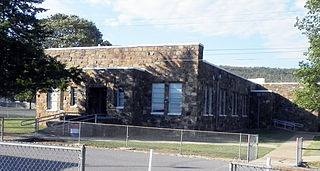
Clayton High School Auditorium is an historic structure serving the public school of Clayton, Oklahoma. Clayton is located in the Kiamichi Mountains of Pushmataha County, Oklahoma.
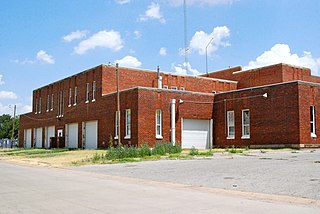
The Enid Armory was located in Enid, Oklahoma and has been listed on the National Register of Historic Places since 1988. The two-story building was constructed in 1936 as a Works Progress Administration project. It was the third largest Armory in Oklahoma.
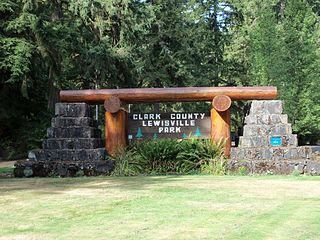
Lewisville Park is a 154-acre regional park located on the East Fork Lewis River, two miles north of Battle Ground in Clark County, Washington. It was listed on the National Register of Historic Places in 1986.
Architects of the National Park Service are the architects and landscape architects who were employed by the National Park Service (NPS) starting in 1918 to design buildings, structures, roads, trails and other features in the United States National Parks. Many of their works are listed on the National Register of Historic Places, and a number have also been designated as National Historic Landmarks.

The Coalgate School Gymnasium-Auditorium is a historic school building in Coalgate, Oklahoma. It is located at the intersection of Fox and Frey streets in Coalgate, Oklahoma and is one of several properties in Southeastern Oklahoma constructed by the Works Progress Administration during the Great Depression. It is listed on the National Register of Historic Places.

The Keel Creek Bridge is a bridge on Oklahoma State Highway 31 seven miles northeast of Coalgate, Oklahoma. The bridge is listed on the National Register of Historic Places. It was constructed as a Works Progress Administration project. The bridge is significant because of its importance to the transportation history of the area and because it is a WPA-built structure.

The Arkoma School in Arkoma in Le Flore County, Oklahoma was a Works Progress Administration-funded project completed in 1937. It was listed on the National Register of Historic Places in 1988.

The Poteau Community Building, in Poteau in Le Flore County in southeastern Oklahoma, is a multipurpose community building built as Works Progress Administration project in 1937. It was listed on the National Register of Historic Places in 1988.

The Tucker School was a three-room schoolhouse built in 1937 as a Works Progress Administration project in a rural area outside of Spiro in LeFlore County, Oklahoma. It was listed on the National Register of Historic Places in 1988.

Twyman Park, on West Street in Poteau in Le Flore County, Oklahoma, has structures built in a Works Progress Administration project in 1937. It was listed on the National Register of Historic Places in 1988.

The Shady Point School, located on the northeastern edge of the community of Shady Point in Le Flore County, Oklahoma, was built in 1936 as a Works Progress Administration project. It was listed on the National Register of Historic Places in 1988.

The Poteau School Gymnasium-Auditorium, located at Walter and Parker Sts. in Poteau in Le Flore County, Oklahoma, was built in 1937. It was listed on the National Register of Historic Places in 1988.
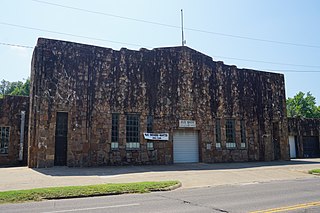
The Idabel Armory in Idabel, Oklahoma was built in 1936 as a Works Progress Administration (WPA) project. It was listed on the National Register of Historic Places in 1988.

The Robert E. Lee School, at Ninth and Louisiana Streets in Durant, Oklahoma, was built in 1937. It was listed on the National Register of Historic Places in 1988.
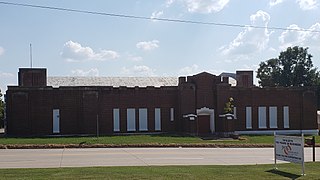
The Holdenville Armory, at US 270 and N. Butts St. in Holdenville, Oklahoma, was built in 1936. It was listed on the National Register of Historic Places in 1936.

The Buffalo City Park Pavilion, on US 64 in Buffalo, Oklahoma, was built in 1936. It was listed on the National Register of Historic Places in 1988.

The Hugo Public Library built in 1936–37, on E. Jefferson St. in Hugo, Oklahoma, was listed on the National Register of Historic Places in 1988. It was a Works Progress Administration project.















